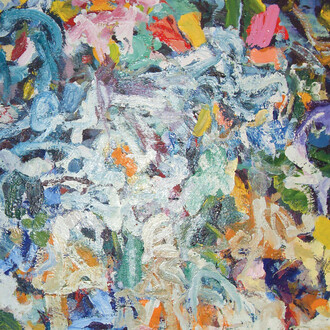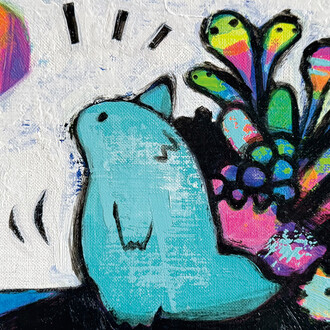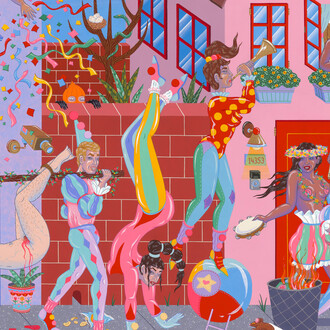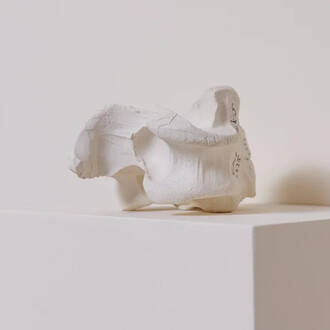Gallery 1: Amaranth Ehrenhalt.
Gallery 2: Carol Barsha, Ernest Briggs, Seymour Boardman, James Brooks, Peter Bonner, Charles Clough, Buffie Johnson, Michael Loew, Louise Nevelson, Richards Ruben, Jon Schueler, and Thomas Sills.
The artists in this exhibit had respect for earlier forms of art. Their development grew from this background and art patrons who exposed them to the importance of other historical forms of expression. Thus, we have abstract art.
(Anita Shapolsky)
Gallery 1
Amaranth Roslyn Ehrenhalt was born in Newark, New Jersey in 1928 and grew up in Philadelphia, PA. She attended the Pennsylvania Academy of Fine Arts and at the Barnes Foundation. In the early 1950’s she moved to New York City where she became friends with many important artists of her generation, such as Al Held, Ronald Bladen, and Willem de Kooning. Before moving to Paris, she had a drink with de Kooning at the legendary Cedar Tavern. He asked her to have dinner with him after her return to New York City, but it never happened. She remained in Paris for almost 40 years, where she met, socialized, and exhibited with artists such as Seymour Boardman, Sam Francis, Shirley Jaffe, and Joan Mitchell. She also knew many recognized European artists such as Alberto Giacometti, Yves Klein, and Sonia Delaunay. Delaunay, who believed in Amaranth’s talent, and strength as a colorist, supported her during her early years in Paris by allowing Amaranth to purchase art supplies on Delaunay’s account. She aided her and her family in many other ways, she was truly Amaranth’s patron.
Amaranth perfectly mastered many mediums, creating paintings, drawings, watercolors, sculptures, mosaics, prints, tapestries, scarves, poetry, and writing. She used bold, dynamic brush strokes and strong, vibrant colors as did Delaunay. She named her works by unique, unusual titles, often referring to specific memories, and reflecting the rich, emotionally loaded, dynamic nature of her work.
She was breathing and living for art and worked tirelessly. She was a true multimedia artist who worked and created until her final days. Her work has been exhibited around the world and has become part of various important art collections, such as the Women Artists collection at the Mougins Museum in France. As a woman artist belonging to the important school of abstraction, her work is an inseparable part of twentieth-century visual arts.
Gallery 2
Ernest Briggs (1923-1984) was born in San Diego, California, in 1923. His work from the 1950s can be characterized by loose abstractions and strong, rhythmic brushstrokes. Some of his works cue Still’s influence but he soon moved away from California Abstract Expressionism. Until his death, Briggs moved through various abstract idioms, sometimes returning, and referencing the earlier work. In the 1960s he freely switched between acrylic and oil, creating large canvases characterized by dark, deep colors or lighter strokes, sometimes with unfinished spaces or on unprimed canvas. A few years before his death Briggs simplified his form while still maintaining his wide color palette.
He brought out the essence of form with maximal intensity in his works. Briggs passed away in New York in 1984 at the age of 61 from cancer. His works are in the collections of The Anita Shapolsky Art Gallery, The Whitney Museum of American Art, The San Francisco Museum of Art, The Carnegie Institute, The Smithsonian American Art Museum, and other institutions.
Seymour Boardman (1921-2005), artistically formed in New York and Paris, before and after WWII, developed and defined his style alongside fellow influential artists like Sam Francis, Larry Calcagno, John Hultberg, and Frank Lobdell. Exhibiting in solo and group shows from the 1950s until his death in 2005, Boardman's paintings can be found in national and international collections.
Boardman's paintings can be recognized by an apparent underlying grid that sets the stage for an orchestration of linear motifs that became more and more simplified over the years. Anita Shapolsky highlights the intellectual European starting point of his work that matured and evolved into an almost jazz-like improvisational musical score of the line moving across the canvas.
His works are in the collections of many major museums and institutions, such as the Whitney Museum, the Guggenheim, the Brooklyn Museum, the Santa Barbara Museum of Art and others.
Peter Bonner (1964-) is an Australian Artist, who in 1996 won the Dobell Prize, the highest prize for Drawing in Australia. In his early 20’s he traveled in India, the Middle East, and throughout Europe, and studied drawing and painting in London, Melbourne, and New York. In 2010 he completed a master’s by Research at Monash University pursuing his interest in Perception, Narrative, and the Primitive. He has been influenced greatly by Australian Aboriginal artists, Russian Icons, and the deserts of Central Australia and the American West. Bonner currently lives and works in NYC.
In 1951, Charles Clough was born in Buffalo, New York. In 1971, he opened an art studio. His paintings are extravagantly colorful and explosively formless.
"In the Clufffalo paintings is a technique that I began using – my ‘big finger-painting tools’, which has evolved into one I call ‘pour and blots’, which literally describes the technique. I find that by not using brushes I can achieve a novelty of appearance that transcends apex. The joy in making these paintings lies in seeing images and effects that only exist through my particular process. I seek to embody the creative imagination such that it can be thought of as a pseudo-organism from an imaginary universe. I seek atmospheres like Redon’s or Bonnard’s, with pareidolia as in Gorky and Tanguy…I believe I’m inventing a new vocabulary of color/shape”.
More than 600 of his artworks are in permanent collections of over 70 museums, including the Metropolitan Museum of Art, The National Gallery of Art, and the Smithsonian.
Richards Ruben (1925-1998) painted in a sculptural way. He drew with his stretcher bars, covering them and shaping the canvas to reflect his interest in how the inner rhythms of the image correspond with the outer image of the canvas as well as the canvas's interaction with the wall.
His work is in the Herbert F. Johnson Museum of Art, University of Southern California, Pomona College, and University Art Museum, University of California. Over 40 of his paper paintings were accepted into the Menil Collection in 2022.
Thomas Sills (1914-2000) married the mosaicist, Jeanne Reynal. Inspired by her collection of abstract art, he began working with materials that his wife used in her mosaics but soon branched out to oil on wood as well as canvas.
Thomas Sills spent most of his creative life in New York City, deeply rooted in the artistic trends as well as cultural issues from the early 1950s to 1970s. Even though he lacked formal training, his self-taught artistic skills released phantasmic abstract paintings. His regular presence in the art world of the 1950s through the early 1970s as an African American painter situated him as an integral element of mainstream and African American art. Thomas Sills, himself however, perceived his art beyond the political; he remained loyal to his commitment to art as a form of expression of the dynamism that escapes any formal constraints.
For more than 30 years, Michael Loew (1907-1985) spent his summers in the Monhegan arts community in Maine where he developed from nature to abstraction. While he often used a grid-like, geometrically inspired arrangement, landscapes primarily inspired his work, and his approach was more painterly and expressive. His energetic application of color captured the harmonic luminous effect of light and space. He stated that a painted surface must retain the transparency of a jewel. His work is in numerous museums nationally and internationally, including the Whitney, the Guggenheim, the Hirshhorn, and Albright-Knox.
Buffie Johnson (1912-2006), born in New York City, studied art in Paris and at the Art Students League. Her earliest works tended toward the Surrealist; then came more abstract canvases of intense color and pure form. In later years, she turned to huge realistic paintings of flowers and other plant forms, which were imbued with texture through their profuse, veiny detail. She is recognized for her exploration of the subconscious and the mystical in her art. Her paintings frequently portrayed dreamlike landscapes and fantastical figures, reflecting her fascination with psychology and the esoteric. She wrote Lady of the beast: ancient images of the Goddess and her sacred animals published by Harper and Row in 1988. In the late 1950s, Johnson was commissioned to paint a huge abstract mural for the Astor Theater on New York’s Broadway, which was well publicized. Johnson consistently aimed to portray divine female power. Her work is in the collections of major museums, including the Guggenheim, the Whitney Museum of American Art, the Brooklyn Museum, and the Museum of Fine Arts in Boston.
At the CSFA, Clyfford Still introduced John Schueler (1916-1992) to the work of J.M.W. Turner whose use of light and color to capture the fleeting effects of the sky deeply influenced him. Similar to Turner, Schueler’s skyscapes would blur the line between abstraction and representation using depth and luminosity to capture an emotive record, visualizing his experiences, including those of World War II. After living in NYC, Schueler relocated to Scotland where the ever-changing skies were a source of inspiration as he pursued creating “a painting most like nature”.
Schueler saw his work as a means of conveying the emotional and spiritual dimensions of the natural world. Subsequently, he would favor minimal shapes, almost eliminating figuration, allowing for a viewer's personal associations to shape their experience. These Skyscapes are the defining aspect of his oeuvre; an exploration of color and emotion, an evocation of nature.
Carol Barsha (1952-) beautifully encapsulates a dreamscape of nature and the world around her. She draws inspiration for her symbolic, sometimes surreal paintings from both imagined and natural phenomena. She aims to explore and capture the beauties of simple and complex structures of the visual world and recreate them. She has been practicing this method since the 1970s and learned from her mentor Phillip Guston.
Louise Nevelson (1899-1988) was an American sculptor who emigrated with her family to the states from Russia. Using old pieces of wood and found objects, she constructed huge walls and enclosed box arrangements of complex and rhythmic abstract shapes. Examples of Nevelson’s work is in 50 museums including the Whitney and the Museum of Modern Art in New York.
James Brooks (1906-1992) was an influential American abstract expressionist painter known for his dynamic and gestural style. He initially trained as a commercial artist before transitioning to fine art. His work often featured sweeping brushstrokes and vibrant colors, reflecting his exploration of emotional depth and spontaneity within abstract forms. Brooks' contributions to the abstract expressionist movement earned him recognition as a leading figure in post-war American art.
















